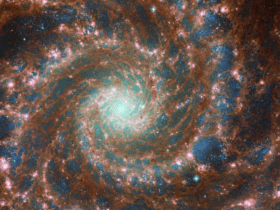A hidden tunnel, stretching thousands of light-years across space, quietly connecting distant parts of the Milky Way like some cosmic highway. Recent studies suggest such an interstellar passage may be lurking near our own solar system, forming part of a vast network of “superbubbles” shaped by ancient supernova explosions. Intrigued yet? Well, buckle up, because this is science fiction made real—and it could mean a whole new frontier for understanding our galaxy.
The Local Hot Bubble: Our Cosmic Cocoon
The story begins with the Local Hot Bubble (LHB), a massive, nearly million-degree pocket of sparse, hot gas that envelops our solar system. This isn’t just any pocket of space; it’s a uniquely shaped cavity formed millions of years ago when a series of supernovae—a few of the galaxy’s largest fireworks—exploded nearby. Researchers from the Max Planck Institute for Extraterrestrial Physics have spent years mapping out this bubble, with a breakthrough view provided by the eROSITA X-ray telescope.
Unlike the uniformly spherical bubbles you might imagine, the LHB has an elongated, almost bipolar shape. Extending over 1,000 light-years, it’s vast enough to dwarf even our solar system. But despite its million-degree heat, the bubble is so low-density that its temperature barely affects anything inside it, including us here on Earth. You might say we’re cruising through it in relative comfort, though scientists are still scratching their heads over its complex structure.
The Discovery of an Interstellar Tunnel
Astrophysicists Michael Yeung and Michael Freyberg recently zeroed in on something unusual within the LHB: a tunnel-like structure pointing toward the constellation Centaurus. Using the powerful eROSITA telescope stationed over a million kilometers from Earth, they found that this so-called “interstellar tunnel” may connect the Local Hot Bubble to another superbubble—or even to the mysterious Gum Nebula, another gigantic hot gas bubble within our galaxy.
This tunnel seems to pass through cooler regions of space, suggesting it could serve as a bridge, a literal “road” through which energy, particles, or maybe even cosmic travelers could theoretically move from one region of the Milky Way to another. If you’re picturing a sci-fi-like wormhole, think of this as its slower, more structural cousin, shaped not by theoretical physics but by supernova shockwaves.
Are We on the Verge of a Galactic Highway Map?
The concept of interconnected bubbles isn’t entirely new. In fact, back in 1974, astrophysicists proposed that the Milky Way might be laced with a network of such superbubbles and tunnels. But without evidence, the theory floated around as more of a fascinating “what-if.” Now, with this new discovery, we may finally have a reason to revisit and validate that early theory.
Imagine a network of tunnels spanning across the Milky Way, connecting different superbubbles, each the result of ancient star explosions that spewed out hot gas and created pathways like cosmic veins. The implications? Well, if these structures do indeed exist, they could allow for more efficient movement of matter and energy across vast stretches of space, potentially affecting star formation and even the future of our own cosmic neighborhood.
A New Era for Space Exploration?
For now, the concept of using this tunnel as a literal highway through the galaxy remains speculative. However, what’s clear is that this discovery adds an exciting layer to our understanding of the Milky Way’s structure. If these tunnels and bubbles are indeed part of a broader cosmic network, then we’re looking at a radically new understanding of how matter—and perhaps even energy—moves and connects across the galaxy.
The next steps for researchers are likely to focus on mapping out these connections in greater detail, a bit like cosmic cartographers charting the unknown. Each discovery brings us one step closer to not only understanding the Milky Way’s history but also unlocking new mysteries about how supernovae have continually shaped and reshaped our galaxy.
So, while we might not be hopping on an interstellar road trip anytime soon, this galactic “infrastructure” hints at a future where understanding these hidden highways could unlock untold secrets about the universe—and perhaps one day serve as a bridge to the stars.











Leave a Reply